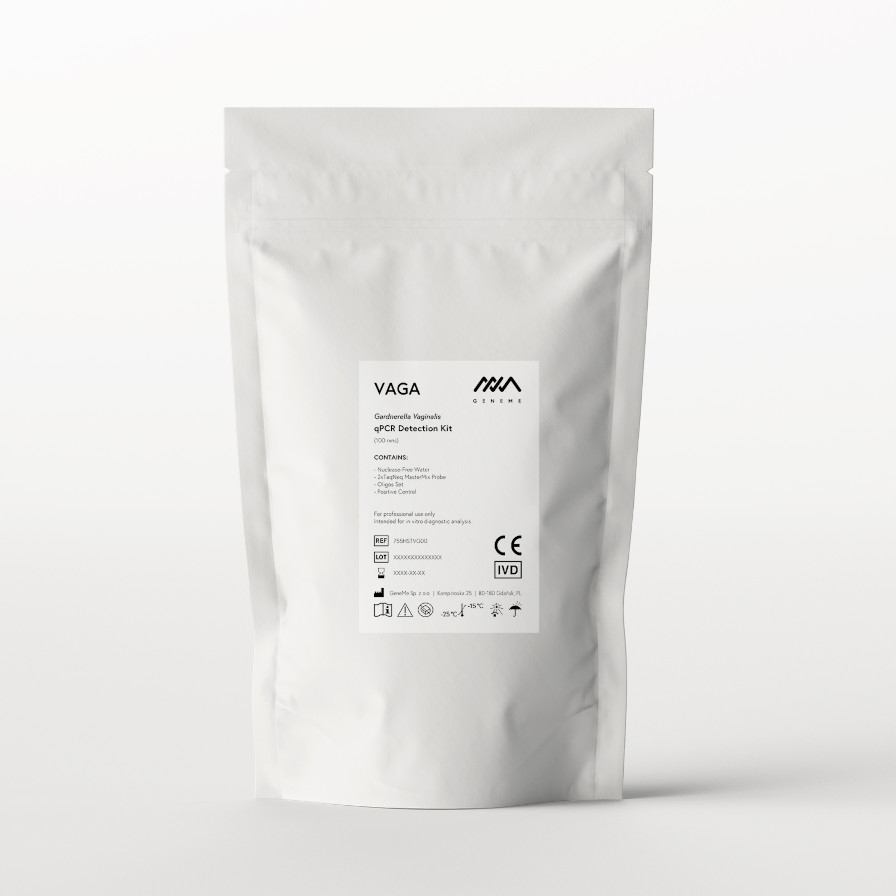VAGA
(Gardnerella vaginalis)
qPCR Detection Kit

Description
Gardnerella vaginalis is a species of Gardnerella, a genus of bacteria belonging to the family Bifidobacteriaceae. Gardnerella vaginalis has been identified as being a commensal in the intimate areas as part of the microbiome in healthy women. In addition, this pathogen may latently infect the chorionic villi tissues of pregnant women, thereby impacting pregnancy outcome.
REF. NUMBER
755HSTGV00
PATHOGENE
Gardnerella vaginalis
KIT CONTENTS
1 × Nuclease-Free Water
1 × 2xMasterMix qPCR Probe
1 × Oligos Set
1 × Positive Control
QUANTITY
100 rxns
STORAGE CONDITIONS
-25°C to -15°C
CERTIFICATES
More Information
Did you know...?
Infection with Gardnerella vaginalis affects many women, but up to 75% of cases may be asymptomatic. The main causes of infection are frequent changes of sexual partners and inadequate hygiene of intimate zones. Normal vaginal microflora in women is characterized by the presence of Lactobacillus bacteria, which are responsible for the acidic environment, and a very small amount of Gardnerella bacteria.
Why knowledge about Gardnerella vaginalis is important?
Among the most common symptoms of women infected with the Gardnerella vaginalis bacteria are vaginal discharge, which is characterized by a rather unpleasant odor, determined by many by the smell of rotten fish. The discharge is usually white or grayish in color. Vaginal discharge very often contains a small amount of leukocytes. Another visible symptom may be a disturbance in the pH of the vaginal mucus. It is significantly different from the correct one and has values greater than 4.5. Some patients also report symptoms such as burning, irritation and itching of intimate zones and pain during intercourse. Infection with Gardnerella vaginalis during pregnancy can lead to numerous complications. The most common are bleeding, chronic inflammation of the urinary tract. If left untreated, bacterial vaginosis can lead to the development of infections of other organs in the pelvic region and urethra. Occasionally, having too much Gardnerella vaginalis can cause premature labor.
How the test is performed?
In the diagnosis of Gardnerella vaginalis, PCR techniques are primarily used to confirm or exclude the presence of the pathogen in the tested material. The advantage of PCR over other methods is unambiguous – the sensitivity and specificity of the test is over 99%, and the method allows the detection of a very small number of bacteria. Genetic material analysis using our reagents is fast and accurate. Following the IFU included in the kit, the lab technician can easily interpret the results. The reaction lasts about 45 min, and the temperature-time profile is selected so that the laboratory can analyze several genes simultaneously using one device. Ready-to-use reagents are included in the kit. It is enough for the lab technician to add each of them in the right proportion and the reaction is ready. Quickly, easily and professionally.
Why is it worth doing a genetic test?
Quick diagnosis will enable the implementation of treatment. Only by means of a genetic test are we able to detect the presence of the pathogen with 100% accuracy.
What can be done after the test result?
Treatment for both men and women is similar. Appropriate antibiotics prescribed by a doctor are used. The partner must also undergo treatment in order to prevent reinfection and the spread of the disease. After using the drugs, it is best to make a follow-up visit, you can also return the sample for testing. Once treated, however, the infection has a tendency to recur.